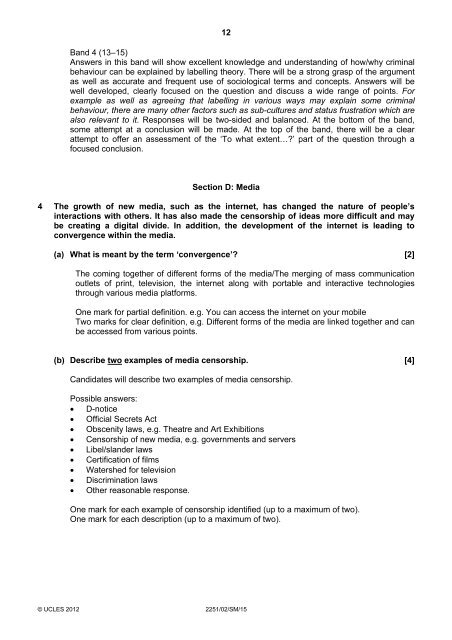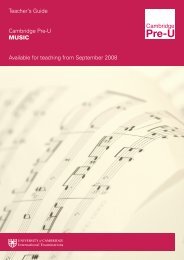MAXIMUM MARK: 70 - Cambridge International Examinations
MAXIMUM MARK: 70 - Cambridge International Examinations
MAXIMUM MARK: 70 - Cambridge International Examinations
Create successful ePaper yourself
Turn your PDF publications into a flip-book with our unique Google optimized e-Paper software.
12Band 4 (13–15)Answers in this band will show excellent knowledge and understanding of how/why criminalbehaviour can be explained by labelling theory. There will be a strong grasp of the argumentas well as accurate and frequent use of sociological terms and concepts. Answers will bewell developed, clearly focused on the question and discuss a wide range of points. Forexample as well as agreeing that labelling in various ways may explain some criminalbehaviour, there are many other factors such as sub-cultures and status frustration which arealso relevant to it. Responses will be two-sided and balanced. At the bottom of the band,some attempt at a conclusion will be made. At the top of the band, there will be a clearattempt to offer an assessment of the ‘To what extent…?’ part of the question through afocused conclusion.Section D: Media4 The growth of new media, such as the internet, has changed the nature of people’sinteractions with others. It has also made the censorship of ideas more difficult and maybe creating a digital divide. In addition, the development of the internet is leading toconvergence within the media.(a) What is meant by the term ‘convergence’? [2]The coming together of different forms of the media/The merging of mass communicationoutlets of print, television, the internet along with portable and interactive technologiesthrough various media platforms.One mark for partial definition. e.g. You can access the internet on your mobileTwo marks for clear definition, e.g. Different forms of the media are linked together and canbe accessed from various points.(b) Describe two examples of media censorship. [4]Candidates will describe two examples of media censorship.Possible answers:• D-notice• Official Secrets Act• Obscenity laws, e.g. Theatre and Art Exhibitions• Censorship of new media, e.g. governments and servers• Libel/slander laws• Certification of films• Watershed for television• Discrimination laws• Other reasonable response.One mark for each example of censorship identified (up to a maximum of two).One mark for each description (up to a maximum of two).© UCLES 2012 2251/02/SM/15
















